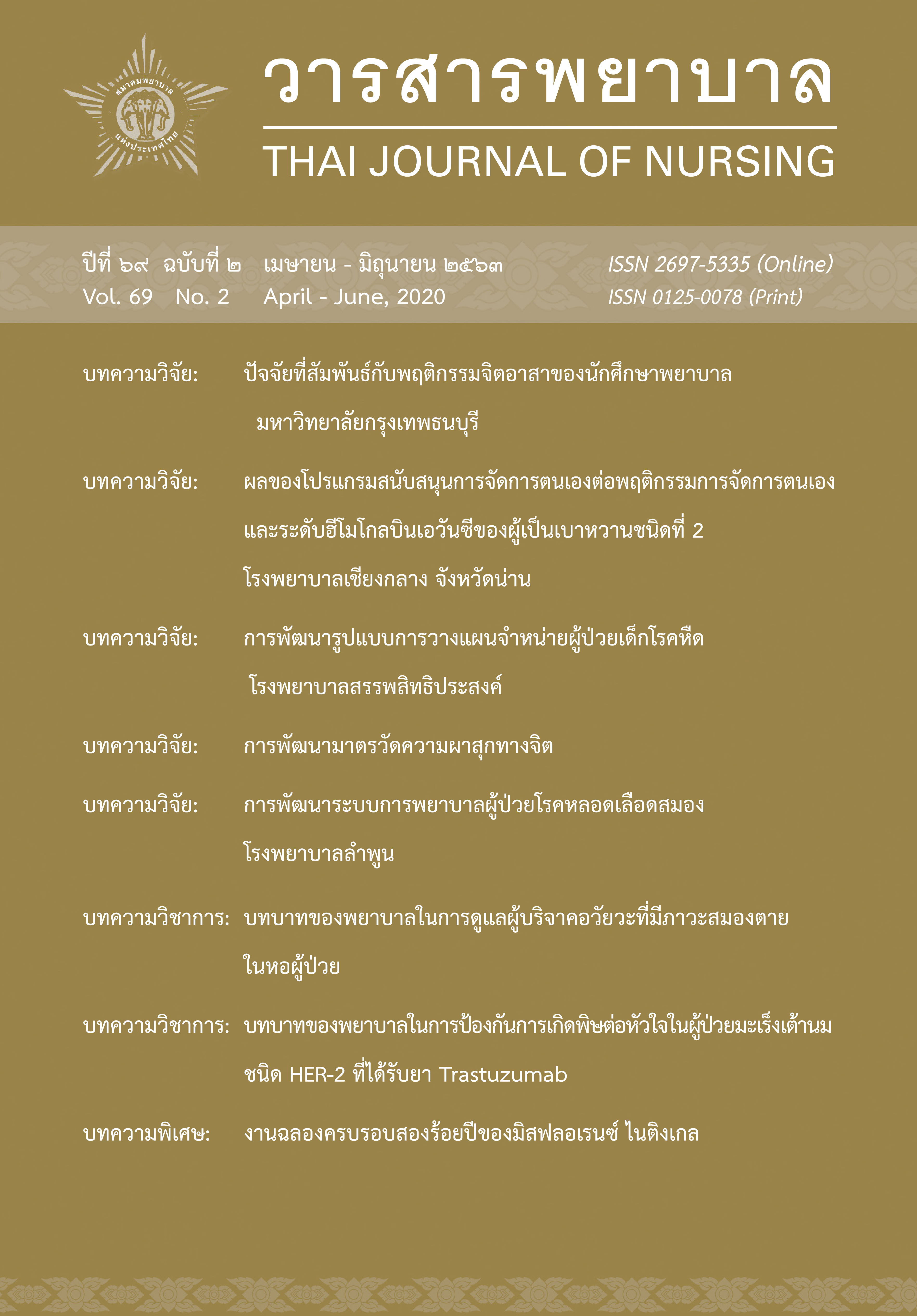การพัฒนามาตรวัดความผาสุกทางจิต
Main Article Content
บทคัดย่อ
การวิจัยและพัฒนานี้มีวัตถุประสงค์เพื่อพัฒนามาตรวัดความผาสุกทางจิตฉบับภาษาไทย กลุ่มตัวอย่างเป็นประชาชนสัญชาติไทย อายุ 18 ปีขึ้นไป ใช้ภาษาไทยในการสื่อสาร เลือกแบบเจาะจง จำนวน 30 คน การวิเคราะห์ข้อมูล หาความตรงเชิงเนื้อหาด้วยดัชนีความสอดคล้องระหว่างข้อคำถามกับจุดประสงค์หรือเนื้อหา และประมาณค่าความเที่ยงโดยใช้สูตรสัมประสิทธิ์แอลฟาของครอนบัค ผลการวิจัยพบว่า 1) มาตรวัดความผาสุกทางจิตแบบพหุมิติฉบับภาษาไทย ที่พัฒนา มีจำนวน 84 ข้อ ประกอบด้วย 6 ด้านได้แก่ (1) อิสระแห่งตน (2) ความสามารถในการปรับตัวเข้ากับสิ่งแวดล้อม (3) ความงอกงามส่วนบุคคล (4) การมีสัมพันธภาพที่ดีกับผู้อื่น (5) การมีจุดมุ่งหมายในชีวิต และ (6 ) การยอมรับตนเอง 2) คุณภาพของมาตรวัดความผาสุกทางจิตแบบพหุมิติฉบับภาษาไทย หาค่าดัชนีความสอดคล้องเนื้อหาและความตรงเชิงวัฒนธรรมได้เท่ากับ 1.00 และค่าสัมประสิทธิ์แอลฟาของครอนบัคได้เท่ากับ 0.84 ส่วนรายด้าน 6 ด้าน เท่ากับ 0.85, 0.85, 0.82, 0.87, 0.88 และ 0.79 ตามลำดับ
Article Details
เอกสารอ้างอิง
ชานนท์ วินิจชีวิต, นภาพร ขันธนภา, ระพีพรรณ พิริยะกุล, และสาธิษฐ์ นากกระแสร์. (2561).
ความสามารถในการซึมซับความรู้และศักยภาพเชิงพลวัตที่มีผลต่อความตั้งใจจะเป็นการจัดการ
สีเขียว. วารสารเกษมบัณฑิต, 19(2), 125-141.
เดชา เดชะวัฒนไพศาล, มณีนุช จันทร์เที่ยง, วรกัญญา ตันติไวทยกุล, และอัจจญา อภิวาท. (2554).
ผลกระทบของสภาพแวดล้อมในการทำงานและคุณลักษณะส่วนบุคคลต่อระดับความคิดสร้างสรรค์.
วารสารพัฒนบริหารศาสตร์, 51(3), 1-33.
นันทกา สวัสดิพานิช, และสุจิตรา เทียนสวัสดิ์. (2554). การแปลเครื่องมือเพื่อใช้ในงานวิจัยข้ามวัฒนธรรม:
เทคนิคและประเด็นที่ต้องพิจารณา. วารสารสภาการพยาบาล, 26(1), 19-28.
นิศากร เจริญดี, สุรีพร อนุศาสนนันท์, อรัญญา ตุ้ยคัมภีร์, และไพรัตน์ วงษ์นาม. (2562). การพัฒนามาตรวัด
ความสุขในการเรียนของนักเรียนอาชีวศึกษา. วารสารพัฒนาเทคนิคศึกษา, 32(112), 124-131.
อมรรัตน์ คำศรีสุข. (2554). ความสุขของนักศึกษาพยาบาลหลักสูตรพยาบาลศาสตรบัณฑิต มหาวิทยาลัย
ขอนแก่น. วารสารพยาบาลศาสตร์และสุขภาพ, 34(2), 70-79.
Abbott, R. A., Ploubidis, G. B., Huppert, F. A., Kuh, D., Wadsworth, M. E., & Croudace, T. J. (2006).
Psychometric evaluation and predictive validity of Ryff´s psychological wellbeing items in a UK
cohort sample of women. Health and Quality of Life Outcomes, 4(76), 1-16. doi: 10.1186/1477-
-4-76
Ajzen, I., & Fishbein, M. (Eds.). (1980). Understanding attitudes and predicting social behavior.
Englewood Cliffs, NJ: Prentice Hall.
Asgari, A., & Kramer, J. M. (2008). Construct validity and factor structure of Persian Occupational Self-
assessment. Occupational Therapy in HealthCare, 22(1), 2-3.
Beaton, D. E., Bombardier, C., Guillemin, F., & Ferraz, M. B. (2000). Guidelines for the process of
cross-cultural adaptation of self-report measures. Spine, 25(24), 3186-3191.
doi: 10.1097/00007632-200012150-00014.
Brek, R. A. (1979). The construction of rating instruments for faculty evaluation: A review of
methodology issue. Journal of Higher Education, 50(5), 650-669.
Cronbach, L. J. (1990). Essentials of psychological testing (5th. ed.). New York: HarperCollins.
Graham, J. M. (2006). Congeneric and (essentially) tau-equivalent estimates of score reliability what
they are and how to use them. Educational and Psychological Measurement, 66(6), 930-944.
Lynn, M. R. (1986). Determination and quantification of content validity. Nursing Research, 35(6),
-385. doi:10.1097/00006199-198611000-00017
Ryff, C. D., & Keyes, C. L. M. (1995). The structure of psychological well-being revisited. Journal
of Personality and Social Psychology, 69(4), 719-727.
Ryff, C. D. (1989). Happiness is everything, or is it? Explorations on the meaning of psychological well-
being. Journal of Personality and Social Psychology, 57(6), 1069-1081.
Widhiarso, W., & Ravand, H. (2014). Estimating reliability coefficient for multidimensional measures:
A pedagogical illustration. Psychology, 21(2), 111-121.


